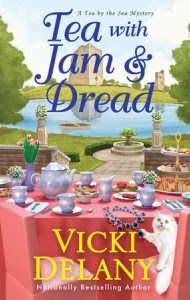 by Sheila Connolly
by Sheila ConnollyYou know about earworms, right? A tune gets into your head and you can’t seem to get it out again? Well, Singin’ Hinnies became a mindworm for me, after I rediscovered it in Mary Berry's cookbook, and I had to try the recipe.
And here’s why: When I was in high school, a friend handed me a book by Mary Stewart and said, “You should read this.” I don’t remember which book it was, but I did read it—and then I read all the others Mary Stewart had written, up through The Crystal Cave. That was my introduction to mysteries (following Nancy Drew, of course). And I still have all the books.
Singin’ Hinnies appear in The Ivy Tree. I haven’t re-read it in a long time, so the details are kind of fuzzy in my mind, but as I recall it involved a false identity and a scam that turned out not to be. Singin’ Hinnies were a clue, if you were paying attention, early in the story. Don’t ask me why I never forgot that particular detail, but it proved a good lesson: if you’re writing a mystery, you have to scatter clues throughout the story, but they won’t seem important until the final “Aha!” moment.
All right, what are singin' hinnies? A kind of tea cake or griddle cake from the north of England. They’re easy to make, and should be eaten quickly.
So here’s the recipe, courtesy of Mary Berry, with a few changes (for instance, she suggested using lard, but I couldn’t quite get my head around that idea).
Singin' Hinnies
Ingredients:
1/2 tsp baking soda
1 tsp cream of tartar
Pinch of salt
1/2 cup vegetable shortening (not butter)
1 cup currants
About 7 oz whole milk
Instructions:
Prepare a griddle or a large, heavy frying pan (cast iron would do) by greasing with oil or vegetable shortening.
In a large bowl, combine the flour, baking soda, salt and cream of tartar and blend. Add the vegetable shortening and rub in with your fingers until the mixture looks like fine breadcrumbs.
Stir in the currants (if yours aren’t fresh, you might want to soak them for a bit in boiling water—then drain and let dry). Add enough milk to make a soft but not sticky dough.
Turn out on a floured surface and knead lightly. Roll into a large round, about 1/4-inch thick. (If your griddle isn’t large enough, you can make two or three smaller ones. And in case you don’t notice, these aren’t exactly round.)
Heat your griddle or pan. Place the cake(s) on it and cook over medium heat for about 5 minutes on one side, then turn and cook the other side for 5 minutes. Both sides should be nicely browned.
Slide it onto a rack, then add butter and serve hot!
You’ll note that there is no sugar in this recipe, although I’m told that the “hinny” part of the name is a slang term for “honey” (both the liquid and the endearment) in the northern part of England. If the currants aren’t sweet enough for you, you can certainly add a drizzle of honey!















































any idea why you can't use butter?
ReplyDeleteI dunno. Mary (who probably has decades of baking experience behind her) said no. But you can certainly try it, and I'm a believer in the "butter makes everything better" theory. Lard might make them flakier, but I kind of balk at the idea of using cow fat (sez she who thoroughly enjoyed eating lardo in Italy--that's preserved but still uncooked pig fat. Did I say I was logical?).
ReplyDeleteThanks to Lucy/Roberta for asking my question about butter.
ReplyDeleteThese do sound comforting.
I eagerly look forward to the newest County Cork adventure. We were supposed to go on a trip in July to the west of Ireland for pub music. Sadly, we have to postpone. So, your book will be my replacement.
I've never made it to the west, although I hear wonderful things about the music. Maybe next year? At least "my" pub (Connolly's of Leap) is up and running again, with a mix of contemporary and traditional music.
DeleteI like your story, the same thing happened to me but it was Agatha Christie. :-)
ReplyDeleteAs for the recipe, I think I might try butter, too, and see what happens. I'm probably the only person in the US who has never used Crisco - lol! The recipe sounds yummy, and coincidentally I have currants on hand this week! :-)
Nicole
I like your story, the same thing happened to me but it was Agatha Christie. :-)
ReplyDeleteAs for the recipe, I think I might try butter, too, and see what happens. I'm probably the only person in the US who has never used Crisco - lol! The recipe sounds yummy, and coincidentally I have currants on hand this week! :-)
Nicole
Nicole, I'm willing to bet it's a very forgiving recipe, and will taste good no matter what. And I found the currants gave the right amount of sweetness.
ReplyDeleteAnother great recipe with an interesting bit of background. I loved the Mary Stewart connection. Thanks for this!
ReplyDeleteXO
MJ
I have to try these, because I love the name and backstory! Thanks, Sheila. Good luck with the new book, can't wait to read it!
ReplyDeleteI read most of Mary Stewart's books also, after seeing the movie, "The Moon-Spinners". I loved that movie!
ReplyDeleteI've always loved (and remembered) the first line of her book My Brother Michael: "Nothing ever happens to me." Yeah, right.
DeleteAnother favorite.
Delete